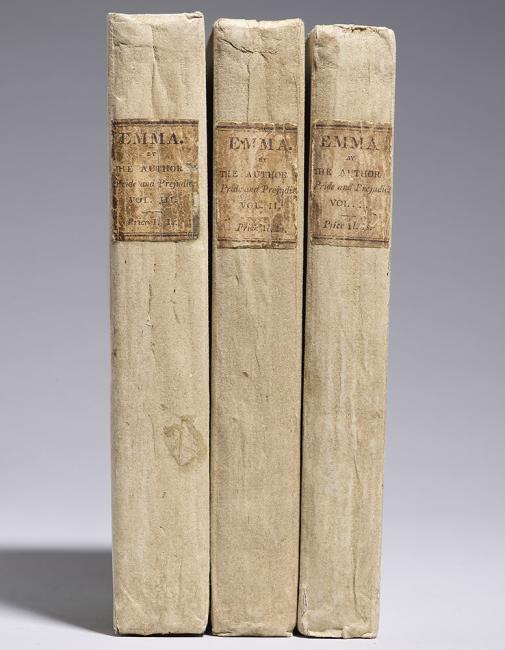Listen to co-curator Juliette Wells explain the process of buying and binding a novel in Austen’s time.

“A MIND LIVELY AND AT EASE”
“Handsome, clever, and rich” Emma Woodhouse indulges in matchmaking and other fanciful pursuits while devotedly caring for her hypochondriac father. In the first passage here, the narrator shows us the village sights that delight Emma, and in the second Austen invents the term “imaginist” to describe Emma’s extraordinary imagination.
Emma occasioned Austen’s most laudatory review. In an unsigned essay, Walter Scott acclaimed her ability to construct compelling narratives out of everyday events and feelings. Austen took a financial gamble by having the prominent publisher John Murray release Emma plus a second edition of Mansfield Park on commission. Lackluster sales left Austen with a profit of less than £39 for both. These volumes are in the publisher’s original bindings, known as “boards.”
Jane Austen (1775–1817)
Emma, 3 vols.
London: printed for John Murray, 1816
The Morgan Library & Museum, purchased by J. P. Morgan Jr., 1928; PML 25476–78
In Austen’s era, books were produced through artisan processes in separate workshops that specialized in paper-making, typesetting and printing, and book-binding. A purchaser received a novel in exactly the state that you see here: a three-volume set bound not in leather but in so-called “boards,” with paper labels on the spines identifying the work’s title and price. After paying a guinea for this set, you had the option to visit your favorite bookbinder and spend even more money having the volumes custom-bound in your choice of leather. The eye-catching family libraries to be seen in historic English houses resulted from generations of investment not only in books themselves but also in a uniform style of binding.
Rebinding in leather helped protect a book against the damage that could result from use. Later in this exhibition, you’ll see a dilapidated library copy of the first American printing of Emma: vivid proof of how vulnerable a book was when it remained in boards. Today, book collectors prize first-edition copies in boards, because they are much rarer than rebound copies. Yet the better preserved such copies in boards are, the less likely it is that they were ever read and reread.
